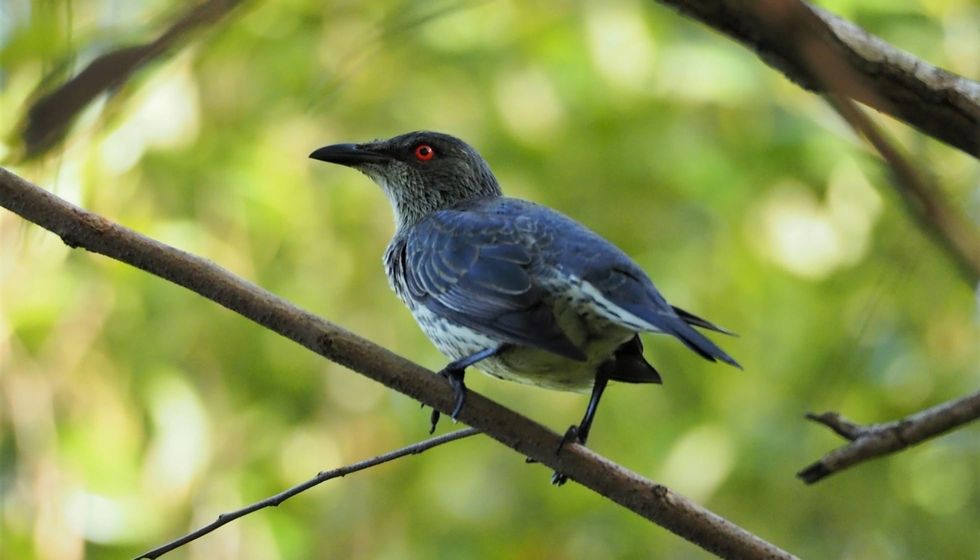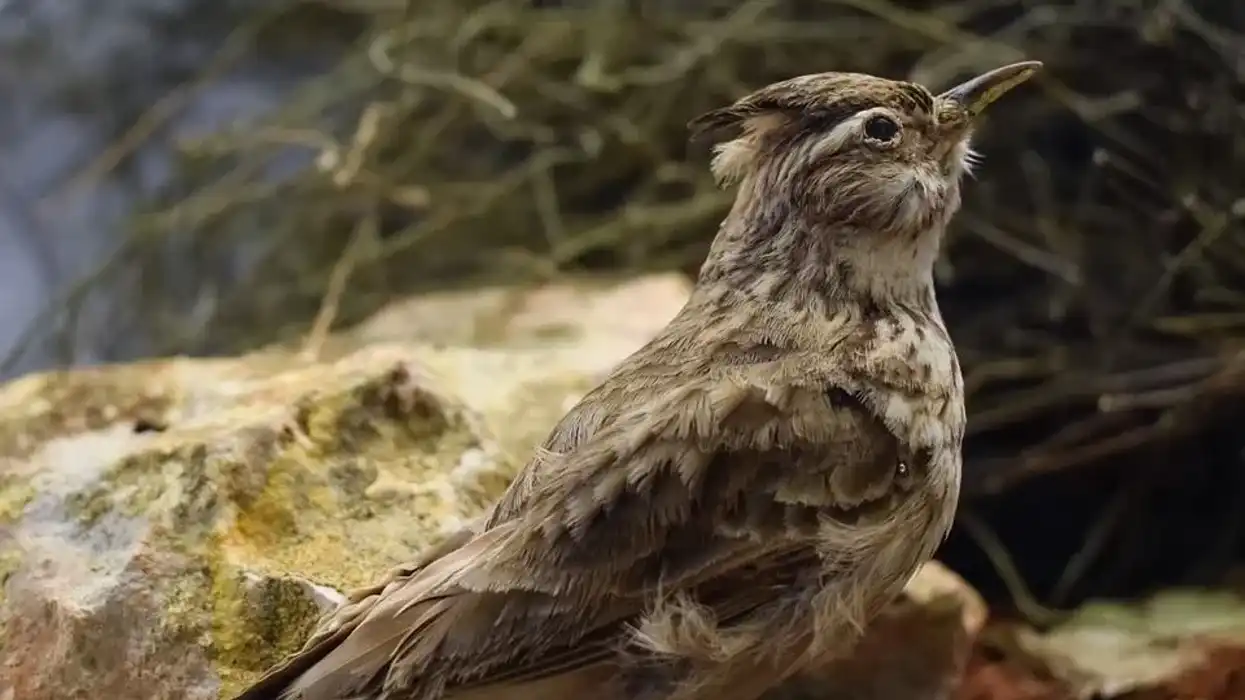Among the several species of birds flying in the blue sky, the Asian glossy starling, Aplonis panayensis, from the order Passeriformes and genus Aplonis, is one of them. The Asian glossy starling, Aplonis panayensis, from the Sturnidae family, is metallic black-green plumage with bright red eyes.
It is one of the noisiest species among the birds of the world. It was first described by an Austrian naturalist, Giovanni Antonio Scopoli in 1786.
The Asian glossy starling, Aplonis panayensis, is known by various names in different countries. For instance, malaienstar in Germany, estornino bronceado in Spain, maleise purperspreeuw in Netherlands, stourne bronzé in France, perling mata merah in Malay, and orientstare in Norway.
The glossy starling (Asian) often resides in tropical and subtropical and tropical areas, moist lowland areas, subtropical mangrove vegetations, cities, and towns. The bird lives in the Asian region of the world including Thai-Malay, Philippines, Singapore, India, Thailand, Bangladesh, Myanmar, and Indonesia.
The bird has several subspecies throughout the world based on its geographic range, i.e.
Aplonis panayensis panayensis in Philippines islands; A. p. affinis ranging from Assam in India, Bangladesh to Myanmar; A. p. strigata in the Malay peninsula, Java, Sumatra, and western Borneo; A. p. tytleri in Andaman, and the Nicobar Islands; A. p. gusti in Bali, alipodis in Panjang, Maratau, and Derawan Islands, and many more.
The subspecies of the starling, Asian glossy strigata, are considered the local subspecies.
If the uniqueness of the Asian glossy starling makes you interested to read more about similar species, you can read about the swallow-tailed kite and blue jay.
Asian Glossy Starling Interesting Facts
What type of animal is an Asian glossy starling?
The Asian glossy starling, Aplonis panayensis, is a species of starling birds of the world, found in Asia. It is also known by various local names such as malaienstar, estornino bronceado, maleise purperspreeuw, stourne bronzé, perling mata merah, and orientstare. It has a range of subspecies, with strigata being the local subspecies.
What class of animal does an Asian glossy starling belong to?
The Asian glossy starling, Aplonis panayensis, belongs to the class Aves, order Passeriformes, Sturnidae family, and genus Aplonis. The search highlighted that the species of the bird is classified into several subspecies based on the geographic distribution.
How many Asian glossy starlings are there in the world?
The population range of the species of Asian glossy starling, Aplonis panayensis, is not computed yet. According to the search, the current conservation status of the Asian glossy starling (Aplonis panayensis) is listed under the category of Least Concern. The bird is a common resident of Thai-Malay, Philippines, Singapore, India, Thailand, Bangladesh, Myanmar, and Indonesia.
Where does an Asian glossy starling live?
The Asian glossy starling, Aplonis panayensis, from the genus Aplonis, inhabits the Asian countries in the world. The birds from the family Sturnidae range from Assam in India, Thai-Malay, Philippines, Malaysia, Singapore, Thailand, Bangladesh, Myanmar, to Indonesia.
The birds also reside in various islands ranging from Andaman and Nicobar Islands in India to Anambus and Natuna Islands. The bird is known with various names around the world.
It is called a malaienstar in Germany. The species of Asian glossy starling is also known as estornino bronceado in Spain, maleise purperspreeuw in the Netherlands, stourne bronzé in France, perling mata merah in Malay, and orientstare in Norway.
What is an Asian glossy starling's habitat?
The habitat of Asian glossy starling, Aplonis panayensis, has a wide range. The birds inhabit areas comprising mangrove trees, it is also caught in and around urban cities.
Nonetheless, the habitat of species of Asian glossy starling birds, from the order Passeriformes, surrounds tropical and subtropical mangrove vegetation, islands, and moist lowlands. The birds are caught perching on abandoned buildings and trees.
Who do Asian glossy starlings live with?
The Asian glossy starling, Aplonis panayensis, is a gregarious species of bird. The search revealed that the birds move in large groups. The flocks of the bird are also recorded to form symmetrical patterns and are quite noisy.
How long does an Asian glossy starling live?
Its lifespan is still a conundrum. While the lifespan of an Asian glossy starling, Aplonis panayensis, is undeciphered, a pink cockatoo is reported to live up to 83 years.
How do they reproduce?
According to research, adult species of Asian glossy starling, Aplonis panayensis, from the genus Aplonis, is recorded to breed throughout the year. On the other hand, the adult bird prefers to mate from March to June.
The flock is reported to dance intricately before landing on the roosting trees. The adult birds build nests in sheltered places and are made up of paper and grass. The adult female birds lay three eggs which hatch into immature birds.
What is their conservation status?
The Asian glossy starling, Aplonis panayensis, first described by Scopoli, is listed as Least Concern under the IUCN Red List of Threatened Species. When it comes to the population size of the Asian glossy starling (Aplonis panayensis), it is noticed that the birds are moving towards abandoned human habilitations from their native habitat.
Asian Glossy Starling Fun Facts
What do Asian glossy starlings look like?
The adult Asian glossy starling, Aplonis panayensis, has glossy dark green feathers having black-purple iridescence. The eyes are bright red in color. The adult bird is slim and has narrow wings. Furthermore, the bill and legs are black in color.
The immature bird, Asian glossy starling (Aplonis panayensis), has brown upperparts and buff-white underparts with dark brown stripes.
The eggs of the Asian glossy starling (Aplonis panayensis) are blue in color with brown spots or blotches.

How cute are they?
The Asian glossy starling, Aplonis panayensis, from the family Sturnidae, has a dark plumage with distinctive iridescence which is sure to attract you. The bright red eyes are another magnificent feature of its identification.
The symmetric form of patterns set by the flocks of the bird is another cute sight to behold. The identification of the flock is quite easy due to the common symmetry portrayed by the species of Asian glossy starling (Aplonis panayensis).
How do they communicate?
The Asian glossy starling, Aplonis panayensis, uses vocalizations to communicate with one another. The calls of Asian glossy starling sound like a short whistle. The birds produce rings and piping calls during their flight. Mimicking sounds of the birds from the family Sturnidae is another magnificent identification as the Asian glossy starling is also known to mimic other sounds.
How big is an Asian glossy starling?
The size of the Asian glossy starling, Aplonis panayensis, varies around the length ranging from 6.6-8 in (17-20 cm). It is twice the size of a hummingbird, the smallest bird, and more than 10 times smaller than an ostrich, the longest bird in the world.
How fast can an Asian glossy starling fly?
The speed of the Asian glossy starling is unrecorded. The slim body and narrow-sized wings help the bird take a swift and direct flight.
How much does an Asian glossy starling weigh?
The Asian glossy weighs up to 1.7-2.1 oz (50-60 g).
What are the male and female names of the species?
There is no sex-specific name assigned to the species of Asian glossy starling (Aplonis panayensis). On the other hand, the species is referred to with various names across the countries. For instance, stourne bronzé in France, the Asian glossy starling (Philippines' species) is called the Philippines' glossy bird, being endemic to the peninsula, and perling mata merah in Malay.
What would you call a baby Asian glossy starling?
The baby Asian glossy starling (Aplonis panayensis) can be called a chick, nestling, hatchling, or fledging.
What do they eat?
Primarily a fruit-eater, the Asian glossy starling, Aplonis panayensis, feeds on a variety of food, including papaya, fig, banana, and mango. The diet also comprises nectar, nuts, and berries. It also preys on insects, spiders, and snails. The African starlings feed on fruits, berries, nuts, insects, and invertebrates.
Are they poisonous?
No, the Asian glossy starlings are not poisonous.
Would they make a good pet?
The starling birds of the world are ideal pets. Due to their social and friendly temperament, they are highly advisable to adopt a group of them or should be left in the wild.
Did you know...
The Asian glossy starling was first described and documented by an Austrian naturalist, Giovanni Antonio Scopoli in 1786.
The bird is native to Singapore but is also found in neighboring South Asian countries.
These glossy starlings are non-migratory.
What do starlings signify?
While a flock of starling is considered a sign of omen, and the starling also signifies the importance of communication in a relationship.
Are Asian glossy starlings endangered?
No, the Asian glossy starlings are not endangered. Moreover, the conservation status is classified as Least Concern, highlighting no risk. Also, subspecies A. p. strigata is the local and most common species of Asian glossy starlings.
Here at Kidadl, we have carefully created lots of interesting family-friendly animal facts for everyone to discover! Learn more about some other birds from our whiskered treeswift facts and vesper sparrow facts for kids.
You can even occupy yourself at home by coloring in one of our free printable Asian glossy starling coloring pages.










